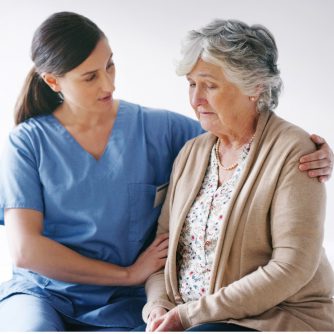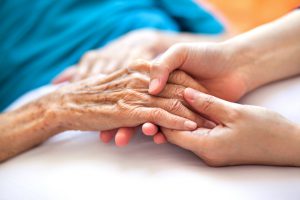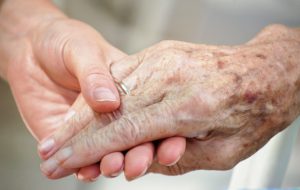Samaritan is a proud provider of Dementia Care and uniquely distinguished as a GUIDE provider by the Centers for Medicare and Medicaid (CMS). Click to learn more.
(856) 596-1600 available 24/7 Refer Now

As end of life approaches for your family member or friend in South Jersey, it is understandable that you may feel apprehensive and have many questions. Facing a loved one’s final moments is scary. But if you know what end-of-life changes to expect, you’ll be able to feel less anxious, and be better prepared.
 End-of-Life Signs
End-of-Life SignsFirst, it’s important to note that each person’s end-of-life experience is unique. It is influenced by such factors as the specific illness, medications being taken, and the person’s overall health. In some cases, these changes may occur over a period of weeks; for others, the process lasts just a few days or hours.
However, a number of end-of-life signs are fairly common, as a person’s bodily functions naturally slow and stop. Common changes include:
The person may only need enough liquid to keep their mouth moist. Offer, but don’t force, food, liquids, and medication. It’s normal that as the person eats and drinks less, their output of fluids will also decrease. Read more about what hospice patients can eat and drink.
Activity usually decreases significantly in one’s final days and hours and it’s natural to sleep more, even during the day. Another common end-of-life change is that people may not respond to questions and may also show little interest in their surroundings. Let your loved one sleep and remain peaceful. Offer reassuring words and touches, but don’t pressure the person to interact. At this point, it is more important to be with, rather than to do for, your relative.
 You may also notice these additional end-of-life signs as the person sleeps more and communicates less:
You may also notice these additional end-of-life signs as the person sleeps more and communicates less:
Patients often breathe through their mouth, causing secretions to collect at the back of the throat. This can cause gurgling, coughing, choking, or even vomiting. To help ease this gurgling, use a cool-mist vaporizer to moisten the air in the room and contact your hospice nurse for additional advice.
When breathing becomes irregular or seems difficult, with periods of no breathing lasting 20 to 30 seconds, the person may moan with each breath. This sound is typically caused by air passing over very relaxed vocal cords, and not due to pain or distress. You can raise your loved one’s head to make breathing easier.Your loved one may become restless and pull on bed linens or clothing, hallucinate, or even try to get out of bed, due to less oxygen reaching their brain. Repetitive, restless movements may also indicate something is unresolved or unfinished in the person’s mind. Play soft music, talk in a calm voice, or read to your loved one. Reassure the person that you are there for them, and that it’s OK to let go. Contact your hospice nurse for additional advice.
Some final end-of-life signs you may see in your loved one include:
 As the end draws near you may notice the person becoming very cold and/or hot, the body loses its ability to control its temperature. In addition, blood pressure gradually falls, and less blood flows to the hands and feet. Arms and legs become cold and bluish in color as circulation slows. The underside of the body may darken, and it may become impossible to find a pulse at the wrist. To help, provide blankets to warm, and cool, wet washcloths to cool.
As the end draws near you may notice the person becoming very cold and/or hot, the body loses its ability to control its temperature. In addition, blood pressure gradually falls, and less blood flows to the hands and feet. Arms and legs become cold and bluish in color as circulation slows. The underside of the body may darken, and it may become impossible to find a pulse at the wrist. To help, provide blankets to warm, and cool, wet washcloths to cool.
As the skin of the feet and hands turn purplish and pale, this end-of-life change usually signals that death will occur within hours to days, and the change in skin may be followed by the person becoming unresponsive. Even while in this state, always act as if the dying person is aware of what’s going on, and can hear what you’re saying and feel you touching them.
People sometimes think that the moment of death will be dramatic, difficult or painful. That is not usually the case, especially when a person dies while receiving hospice care. Hospice providers work to alleviate patients’ pain and discomfort. Read more: What is hospice care?
In fact, the signs of death are often subtle. It may take a few minutes to realize the person has died, rather than just being asleep or unresponsive.
When someone dies, you many notice the following end-of-life changes:
What to do when death occurs:
If the patient is receiving hospice care at home, call the hospice organization. Do not call 911 or any other New Jersey emergency number. The hospice nurse will help you with any calls to the physician and funeral home of your choice.
If the patient is receiving care at an inpatient hospice center or other facility, notify a staff member.